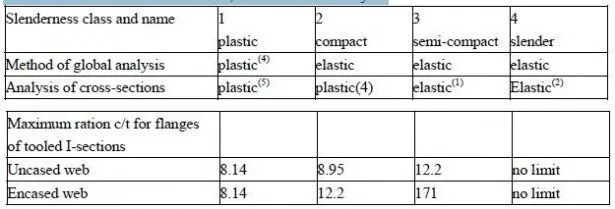In the fairly dry environment of a building, an unrestrained concrete slab could be expected to shrink by 0.03% of its length (3 mm in 10 m) or more. In a composite beam, the slab is restrained by the steel member, which exerts a tensile force on it, through the shear connectors near the free ends of the beam, so it apparent shrinkage is less than the free shrinkage. The forces on the shear connectors act in the opposite direction to those due to the loads, and so can be neglected in design.
The stresses due to shrinkage develop slowly, and to are reduced by creep of the concrete, but the increase they cause in the deflection of a composite beam may be significant. An approximate and usually conservative rule of thumb for estimating this deflection in a simply supported beam is to take it as equal to the long-term deflection due to the weight of the concrete slab acting on the composite member.
In the beam studied in Section 3.11, this rule gives an additional deflection of 9 mm, whereas the calculated long-term deflection due to a shrinkage of 0.03% (with a modular ration n=22) is 10mm.
In beams for buildings, it can usually be assumed that tabulated span/depth rations are sufficiently conservative to allow for shrinkage deflections; but the designer should be alert for situations where the problem may be unusually severe (e.g. thick slabs on small steel beams, electrically heated floors, and concrete mixes with high free shrinkage).
Composite beams also deflect when the slab is colder than the steel member. Such differential temperatures rarely occur in buildings, but are important in beams for bridges. Methods of calculation for shrinkage and temperature effects are given in Volume 2.
1 thought on “Effects of shrinkage of concrete and of temperature”
Comments are closed.


It’s well appreciated.